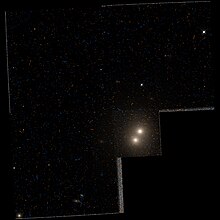NGC 326
| Galaxy NGC 326 |
|
|---|---|
| SDSS recording | |
| AladinLite | |
| Constellation | fishes |
|
Position equinox : J2000.0 , epoch : J2000.0 |
|
| Right ascension | 00 h 58 m 22.7 s |
| declination | + 26 ° 51 ′ 55 ″ |
| Appearance | |
| Morphological type | E + pec |
| Brightness (visual) | 13.3 mag |
| Brightness (B-band) | 14.3 mag |
| Angular expansion | 1.4 ′ × 1.4 ′ |
| Surface brightness | 14.1 mag / arcmin² |
| Physical data | |
| Affiliation | Zwicky 0056.9 + 2636 |
| Redshift | 0.047400 +/- 0.000100 |
| Radial velocity | 14210 +/- 30 km / s |
|
Stroke distance v rad / H 0 |
(642 ± 45) · 10 6 Lj (196.7 ± 13.8) Mpc |
| history | |
| discovery | Heinrich Louis d'Arrest |
| Discovery date | August 24, 1865 |
| Catalog names | |
| NGC 326 • UGC 601 • PGC 3482 • CGCG 480-026 • MCG + 04-03-025 • 2MASX J00561836-1040258 • GC 5132 • IV Zw 035 | |
NGC 326 is a double system consisting of a radio galaxy and a companion galaxy, which are together surrounded by an envelope of hot gas with an unusual structure. Located in the constellation of Pisces, approximately 642 million light years from the Milky Way, the pair are the brightest member of a small group of galaxies called Zwicky 0056.9 + 2636.
NGC 326 was discovered by Heinrich Louis d'Arrest on August 24, 1865 .

Photo from the Hubble Space Telescope

